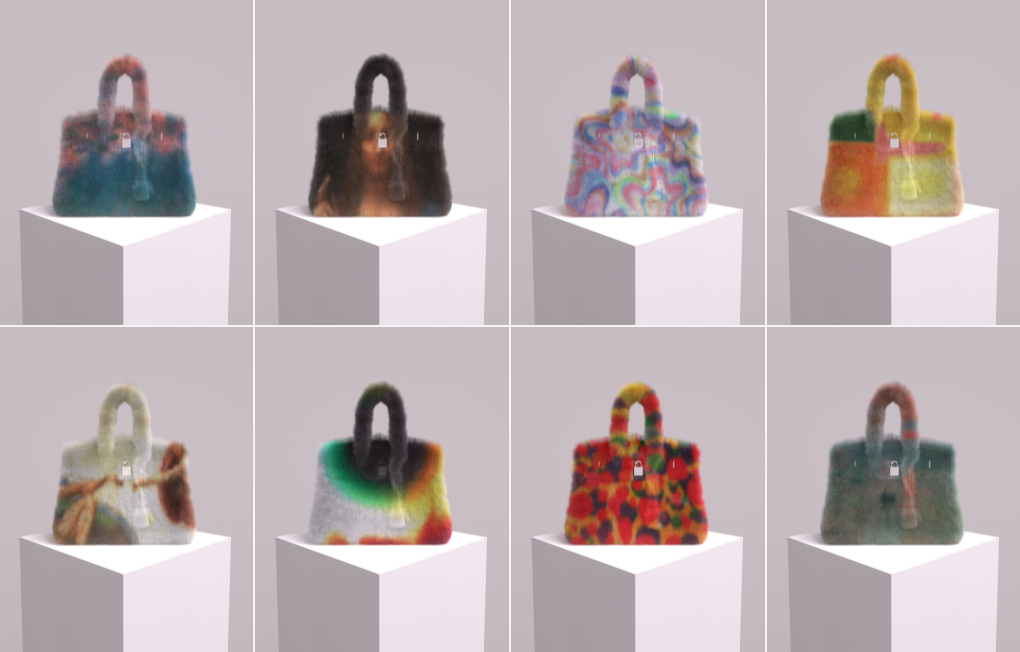
Roughly eight months have passed since Hermès, the French luxury brand behind the famously pricey Birkin handbag, scored a legal victory over a digital artist known as Mason Rothschild, who produced a line of handbag-themed NFTs called MetaBirkins.
“This is not the end of the case,” the artist told Artnet News at the time, after the five-day trial that saw a federal jury conclude that he had violated Hermès’s Birkin trademark rights. And indeed, he has pressed on, appealing to the U.S. Court of Appeals for the Second Circuit.
In the opening brief filed on November 3, attorneys for Mason Rothschild argued that the court erred in denying his dismissal and summary judgment requests. It also said that the court’s instructions to the jury were “prejudicial,” and claimed that expert testimony from writer and Warhol expert Blake Gopnik was erroneously omitted.
In a further development, a group of prominent artists led by MSCHF—the collective famous for its internet-devouring Big Red Boots, among other things—along with Jack Butcher, and free speech advocates Authors Alliance, have filed a 30-page “amicus brief,” strenuously arguing against the February ruling. (Today marked the deadline for amicus briefs related to the appeal.)
The fiercely argued missive calls on a load of art history references and precedents, framing the precedent set by the MetaBirkin case as a threat to the First Amendment. As an art collective, MSCHF has been known for blurring the line between fashion and cultural commentary—and true to form their amicus brief stresses that brands and artists alike have an interest in setting a generous standard when it comes to appropriation, blurring the expected lines.
A paper bag entitled “I shop therefore I am” by U.S. artist Barbara Kruger during the exhibition “The Rise of Supreme / 30 years of American urban culture” at Artcurial auction house on May 14 2018 in Paris, France. (Photo by Chesnot/Getty Images)
“Just as creators borrow from brands to communicate, companies borrow from creators to develop iconic trademarks and add their own sales pitches to leverage meaningful symbols and icons,” the brief’s summary states. As an example, it cites Barbara Kruger’s 1987 I shop therefore I am artwork, “which uses a red box with white text in Futura Bold Oblique font to express her criticism of consumer culture.”
They note that in 1994, streetwear and skateboard company Supreme gave its designer a portfolio of Kruger’s work to help develop a logo. “The resulting, now renowned, logo inverts Kruger’s message while borrowing her aesthetic to suggest that Supreme is a rebellious brand ‘outside fashion’.”
Similarly, it notes Starbucks borrowed its name from “First Mate Mister Starbuck” in Herman Melville’s novel Moby Dick, and that the mermaid on the company’s coffee cup is another literary figure, Melusine, a mythical siren of medieval Europe.
While Starbucks references literary and medieval symbols to amplify its own trademark’s expressive function, the logo “now carries its own independent expressive value. Others may, in turn, use that value to comment upon and critique Starbucks. For instance, variations of the Starbucks logo are used by labor groups to critique Starbucks’ own practices…”
Image via court filings.
The brief even flips the script on Hermès itself, noting that it took the name of its Birkin bag from British actress and singer Jane Birkin, who was often photographed carrying a straw basket stuffed with keys, makeup, and assorted paraphernalia. “As Hermès used Jane Birkin’s name to amplify its own brand’s expressive function, [Mason] Rothschild seeks to do the same as he references the status of a luxury Hermès handbag in his artwork to comment on and critique Hermès’s brand and mark.”
NFTs like MetaBirkin, of course, are inherently wedded to commerce—and specifically to cryptocurrency, a realm that is associated with scams and speculation. The last half dozen pages of the MSCHF/Jack Butcher/Authors Alliance amicus brief hammer home the fact that commercial aims do not invalidate art: “Throughout history, famous works of art have been produced for profit, and they are no less expressive for it.”
This section goes into the history of art and commerce. “For hundreds of years, art was created under a patronage system,” it argues. “Artists such as Michelangelo, Sandro Botticelli, and Leonardo da Vinci worked with the support of wealthy benefactors like the Medici family, among others.” It offers a capsule history of other, more recent examples where art and commercial aims overlap, from Picasso’s Guernica to Mark Rothko’s (eventually scuttled) “Seagrams Murals” for the Four Seasons in New York to Andy Warhol’s general love of money.
“Artists may pursue their crafts in ways that allow them to earn a living, and the need for pecuniary gain has no impact on a work’s expressive value,” according to the brief. “Financial motivations do not and cannot have any legal impact on the amount of First Amendment protection that a work of art receives.”
In a statement shared by his lawyers, Mason Rothschild also put the appeal in a bigger perspective. “This case transcends MetaBirkins,” he wrote. “It’s pivotal for the future of artistic freedom, ensuring that cutting-edge creative expression isn’t hindered by archaic legal interpretations.”
Attorneys for Hermès did not immediately respond to request for comment.